Guide to See the Northern Lights in Iceland
If there was one thing I wanted to do when I first visited Iceland, it was to see the Northern Lights. We all know Iceland has some amazing landscapes, but catching the Northern Lights dancing above it would be the icing on the cake of any trip to Iceland.
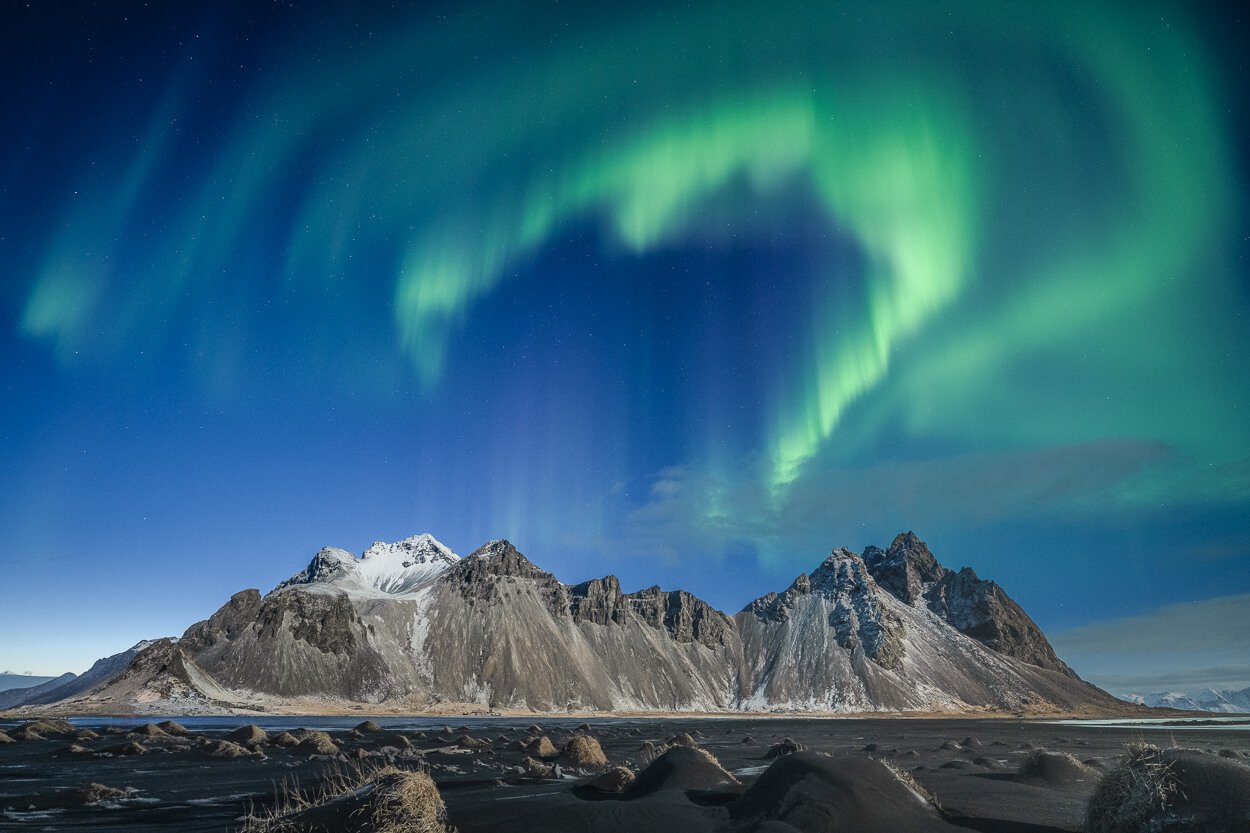
Northern Lights above Vestrahorn. March 2024.
Yet, the Aurora Borealis is an elusive phenomenon, a hard-to-catch one. Sometimes the skies are clear, but there are no Northern Lights, and sometimes there is cloud cover and the lights dance above the clouds. No one knows for sure when they will appear and for how long, even when the forecast is favorable.
Seeing the lights is a bit of a hunt, a chase if you will. And the planning, the anticipation, the chasing, the waiting are part of the whole experience. And when you finally catch the light, it’s a quite a buzz, and an experience like few others.

In this post, I will provide some essential tips for you to plan and hunt the northern lights on your own in Iceland. I’ve done this solo since 2014, the first time I saw them in Iceland, so hopefully you can find some useful tips to plan this on your own. The Aurora Borealis is one of those phenomena I wish everyone could witness at least once in their life – all the better if you can do it in such a beautiful country like Iceland.
Table of Contents
Planning a northern lights hunting trip in Iceland
My first tip on planning a northern light trip to Iceland is to stay flexible in your itinerary. If your primary goal is to see the northern lights, you want to be where the clear skies are at night. Sometimes that means having to drive around a bit to where the clearest skies are.
If you are on a campervan trip, you already have all the flexibility you need. You can read my trip report on a winter hiking and northern lights trip to get an idea of what flexibility means in Van. If you rented a car, be prepared to drive around at night. There may be a spot with no cloud cover within a radius of a 1-2 hour drive. If you are staying in hotels or guesthouses, try to book fully refundable accommodations. This allows you to cancel and rebook at other places if you find clear skies elsewhere.
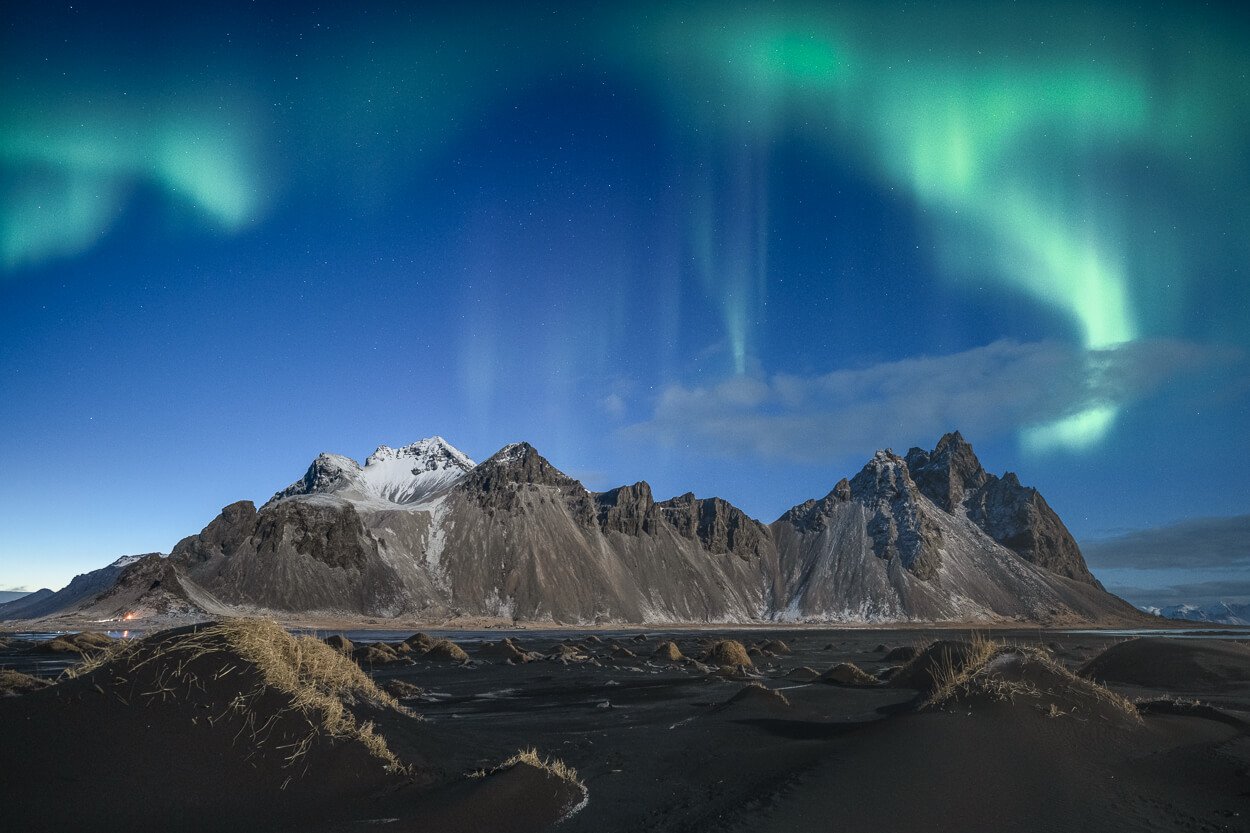
Plan to be in Iceland for more than a few days. If you plan for a 2-3 or even 4-day weekend, you’d be very lucky to catch a glimpse of the Northern Lights. It’s not impossible, but much luck would have to be with you. To give you an example, I consider myself lucky if I can see them twice on a two-week trip. I heard of people who saw none during their two-week vacation, more than people who were lucky to see them on a weekend trip. So I would recommend at least a full week to increase your chances.
Lastly, do not exclusively plan a trip around seeing the Aurora Borealis in Iceland. Do plan other stuff as well. You can try to optimize your chances of seeing the northern lights, but there is no guarantee of seeing any. So what if you planned a trip to see the northern lights and did not see any? If you planned for other stuff as well, you’ll still have great memories when you’re back home – not just the disappointment of not having seen the lights. Iceland is beautiful during its winter season, and well worth exploring in itself.
When to Go and Best Months to See the Northern Lights in Iceland
Technically, it’s possible to see the northern lights from late August to early May. Technically. Practically, to optimize your chances, I would recommend trying only from mid-late September to early-mid April at the latest.
You need darkness to see the northern lights, and there is little to no darkness in Iceland between May and August. You still have a few chances of seeing the Northern Lights in early May or late August, but it’s rather uncommon
If you can, plan around the equinoxes. For some reasons that are not 100% understood yet – maybe related to the tilt of the earth – the lights appear to be more intense at than times of the year. Around that time of the year, the weather is also better than in the middle of winter, and daylight/night hours are more balanced, so it’s a good mix to chase the Aurora and visit other places during the day too.

Aurora Borealis in Late September.
How to increase your chances of seeing the Northern Lights in Iceland.
With the basics covered, here’s how you can optimize the chances of seeing the lights. This is the same process I follow when I am out there. Pretty much everywhere I go to see the lights, and not just in Iceland.
Find the darkest skies at night
First off, you should be in a location with as little light pollution as possible. Light pollution will influence how well your eyes will be able to perceive the lights when they appear. Weak displays may not be visible at all in areas with high levels of light pollution, while they are more likely to be visible in areas with very low levels of light pollution. There are several websites you can use for this purpose – I personally use ClearDarkSky.
There does not need to be total darkness, but you should still try to get as far away as possible from city lights and inhabited hubs. Many of the most beautiful locations in Iceland around the ring road already meet this requirement. Iceland is sparsely populated outside of the capital area, and it’s quick and easy to get out of smaller towns.
If you are in the Reykjavik area and want to see the Northern lights and have a car, I’d actually recommend driving to Thingvellir, if road conditions allow it. Otherwise, a popular spot in Reykjavik is the Grótta lighthouse.

Jokulsarlon is undoubtedly one of the most scenic spots to see the northern lights in Iceland, one with very dark skies too.
Check the weather forecast for clear skies
The first thing you want to do is to be out there where there is as little cloud cover as possible. The Iceland Meteorological Office’s website offers this service. You can easily check the cloud cover on Vedur.is.
One thing to keep in mind is that the weather in Iceland can change fast, and the weather forecast is rarely accurate more than 1-2 days out. Sometimes not even that. For this reason, I’d recommend checking multiple weather forecast apps, like Windy or any other app you may be using, and then decide for yourself which spot looks best.
However, never wait for the perfect conditions to go out. It’s worth trying to go out even if there is partial cloud cover. There can be a break in the clouds at any moment. I took the following photos in 2014, when almost total cloud cover was expected. To make things worse, there was haze and gas pollution from the Bárðarbunga eruption (which you can see glowing red in the middle of the first photo.
It had been cloudy the whole evening, but then suddenly there was a brief break in the clouds, for about 20 minutes. Then it went back to full cloud cover.
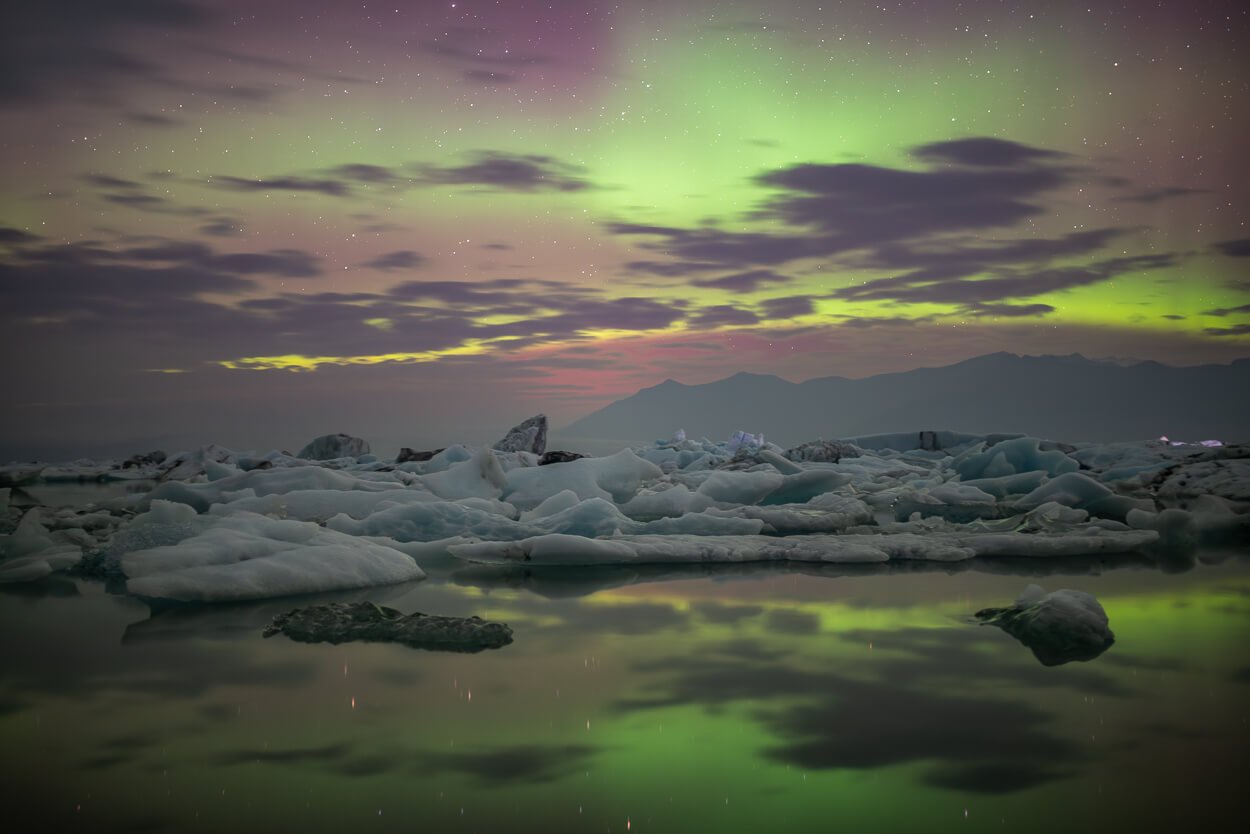
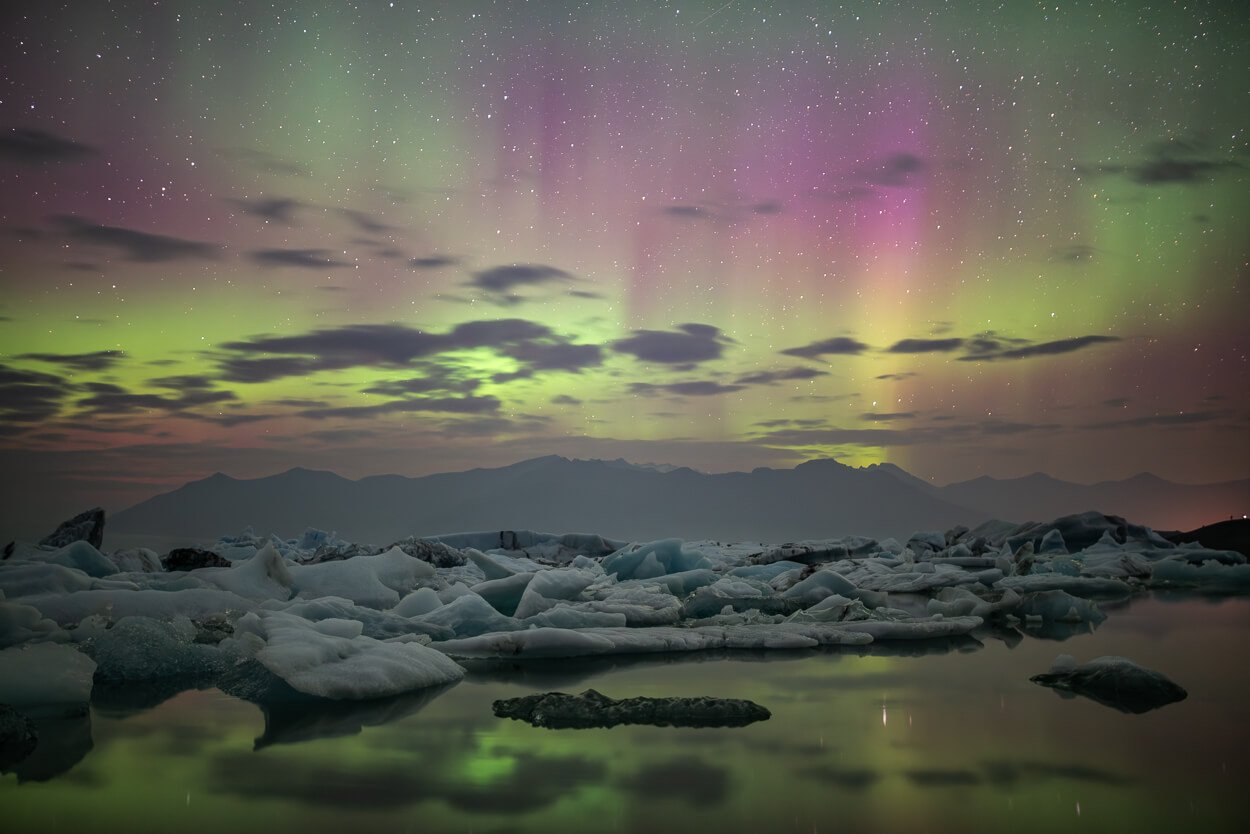
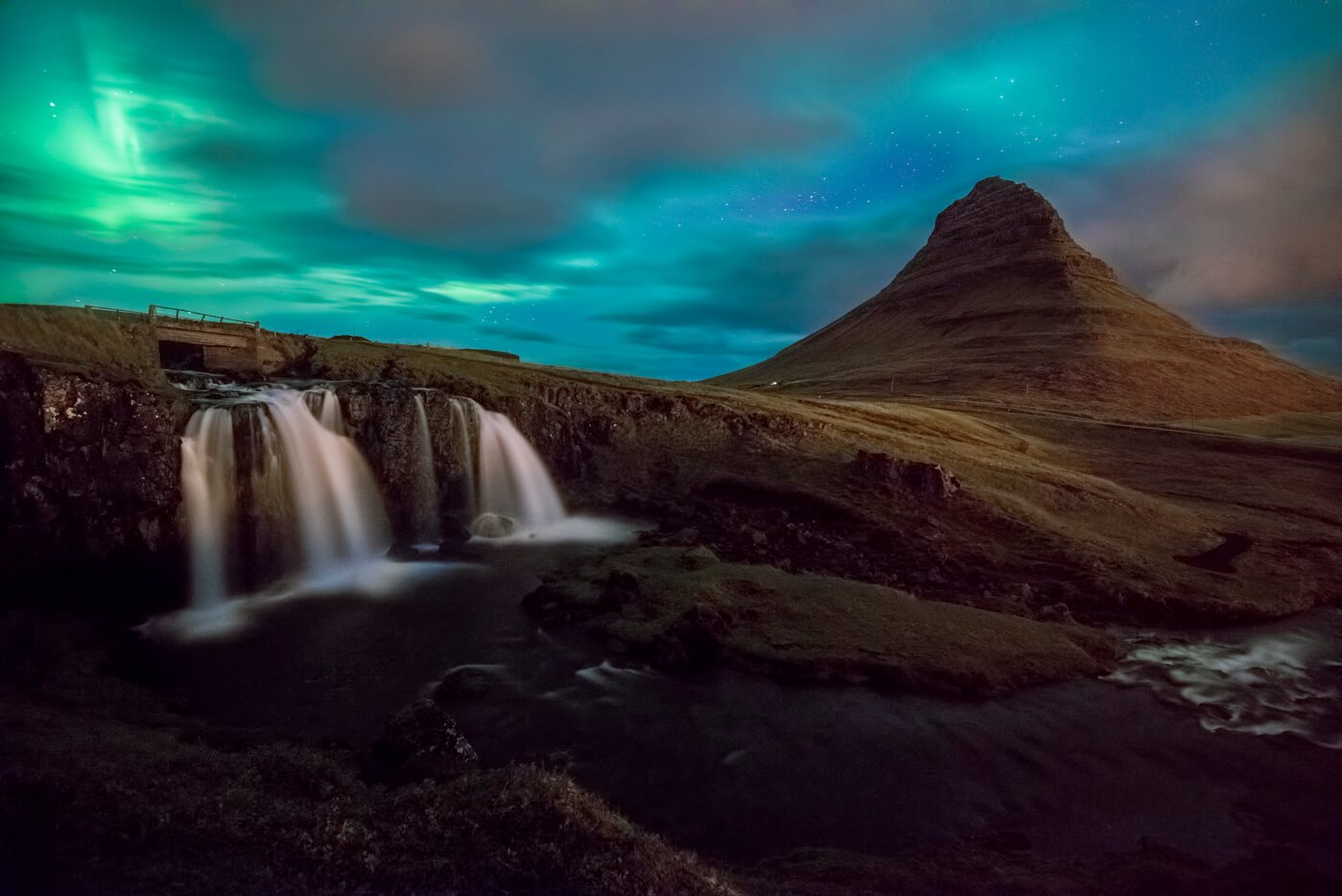
So never wait for the perfect conditions. The more time you spend outdoors, the better.
Check the expected aurora activity: the quick and the thorough check
There are different ways to check the expected aurora activity. From easy, all-in-one predictions to more thorough do-it-yourself forecasts. I’ll describe both below.
The quick way to check the expected activity – the KP Index
You may have heard or not about the KP index, but essentially, it is the index that measures the expected level of disturbance of the Earth’s geomagnetic field caused by the solar wind. This roughly indicates what level of activity we should expect. The KP index is measured on a scale from 0 to 9.
This is what people most commonly use, as this index is easily accessible on a variety of websites. Sites I’d recommend checking are Vedur.is’s forecast or Perlan’s forecast. The latter combines cloud cover with the KP index on one page, while you’d have to check that separately on Vedurs
This is good enough in most cases. However, the KP index is only part of the story, and for a more accurate, thorough do-it-yourself prediction, there are an additional couple of values you may want to check, like the BZ and HP values, which brings us to the next point.
The thorough way to check the expected activity – BZ and HP values
For a more thorough check to optimize your chances, you may want to check the BZ and HP values and the Solar wind speed on dedicated space weather sites. Then, combine them with a cloud cover forecast like Vedur.is’s.
- The BZ Value is the north–south component of the interplanetary magnetic field (IMF), measured in nanoteslas (nT)
- The HP value is the Hemispheric Power index, and shows total energy deposited by charged particles into the upper atmosphere in the Northern Hemisphere.
- The Solar wind speed refers to how fast these charged particles (mostly electrons and protons) from the Sun hit Earth.
What you would need to look for is a negative BZ value, and ideally an HP value at least between 20 and 40 GW, ideally above 50GW. With these conditions and a solar wind speed above 500km/s, it’s party time!
My go-to site I use to check these values is Space Weather Live. You have all the values you need on one page.
Be out by sunset!
Now with the forecast and location choice tips out of the way, let’s tackle a myth. You do not need full darkness to see the northern lights. I know I said the darker the skies, the better, that does not mean no lights under slightly brighter skies. There are good chances to see the lights during twilight too. I have seen them myself several times while to horizon was still glowing orange from the sun that had set earlier. This photo is from Norway, but you get the idea:

Northern Lights over Skagsanden Beach, Lofoten, Norway.
So you do not need to go to sleep early and set the alarm clock to 1 or 2 AM. Don’t wait for darkness to set in fully. Be out there from sunset. I know, you may be tired and hungry after a long day out, but it’s not uncommon for the aurora to appear at dusk already.
Pack some dinner and head to a scenic spot you enjoy, or bring a thermos with a warm drink. Or sit in the car and listen to some music. Sit back and watch the sky. At this point, it’s a waiting game. So on to the next tip.
Your most important asset to see the Northern Lights in Iceland: Patience
This is the asset you’ll need the most: patience. It’s not unusual for me to stay out for 2 or more hours before catching a glimpse of the lights. No one knows when they will appear. It can be within half an hour, or it can be in two hours.
Make it comfortable or enjoyable. If the skies are clear and you are in a dark spot with little light pollution, the starry night sky is a show on its own. Especially if you live in a big town where you rarely get to see the thousands of stars or the Milky Way, you’re in for a show on its own. You won’t believe how many stars you can see in total darkness; it’s an amazing sight.
But back to the lights. Be patient, comfortable, and warm. Look around you constantly. Quite often, the lights begin with a weak display, like a faint gray cloud or mist in the sky. They also often go in waves, so they go from a gray cloud to one or two straws dancing in the sky, to full-blown multi-colored skies during high activity nights.
Then, they rather suddenly disappear. They may reappear in half an hour, or in two hours, who knows. If you feel you’ve seen enough, head for a night of well-deserved rest.

Northern Lights and the Moon at Seljalandsfoss.
Best Apps and Sites to Catch the Northern Lights
Lastly, here’s a collection of Websites and Apps I mentioned in this post and more. Just so you have all the useful links in one place.
- Vedur.is for meteo, could cover and basic Aurora Forecast
- Perlan’s forecast – for a more in-depth forecast
- Space Weather Live for the most accurate, do-it-yourself activity forecast
- ClearDarkSky to find the darkest skies around you
- Apps: if you want to rely on one app, the best I found are Hello Aurora and My Aurora Forecast & Alerts (Apple – Android)
Should you book a Northern Lights guided tour?
I have strong opinions about the Northern lights tour. I have never been on one and never will. They are very expensive, and they do not do much other than drive around to where there is less cloud cover. This is something anyone with a car can do. With the tips provided in this post, you should be able to chase and (hopefully) see the lights yourself, without having to spend money on tours.
So, I’d actually proactively encourage everyone to try and catch the lights by themselves. To me, that’s part of the experience too, the planning and the waiting, making it all the more rewarding when you finally catch them.
The only scenario I think Northern Lights Tours are worth it, is if you don’t have the option to rent a car and drive around by yourself. If you want to go on one, make sure you book one that includes a second try for free, should you not see the lights on the first attempt.
Additional Resources
- For more in-depth tips, check my extensive post on How to See the Northern Lights.
- For photography tips, check my other post on How to Photograph the Northern Lights.
- Also read my trip report on a winter hiking and northern lights.
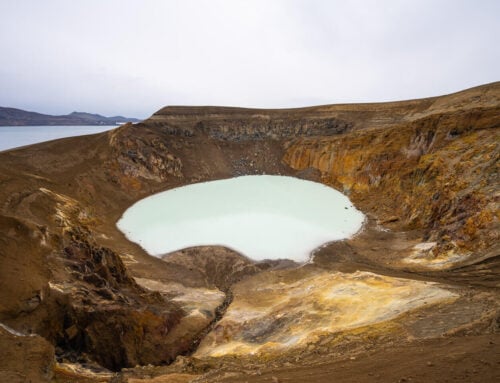
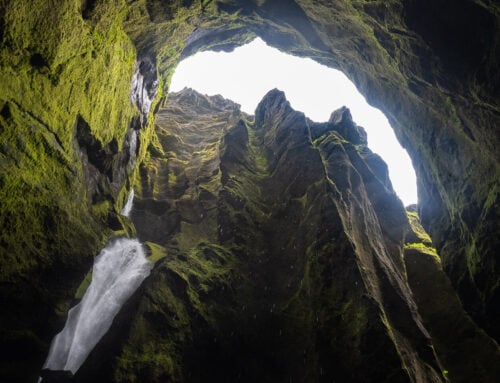
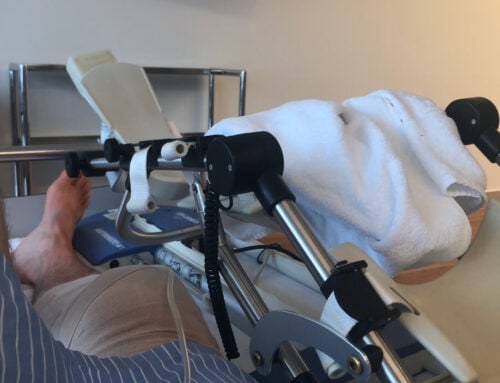
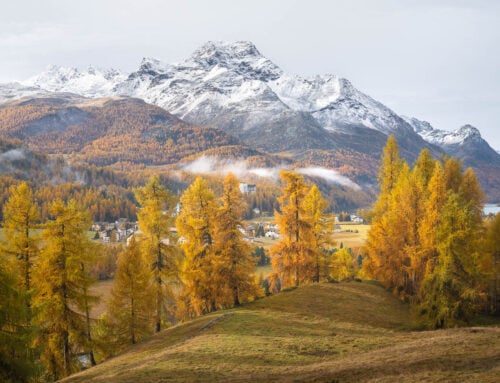
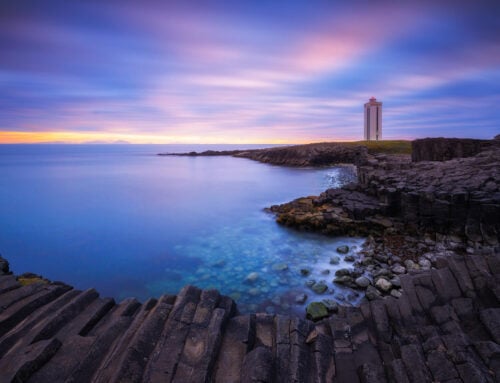
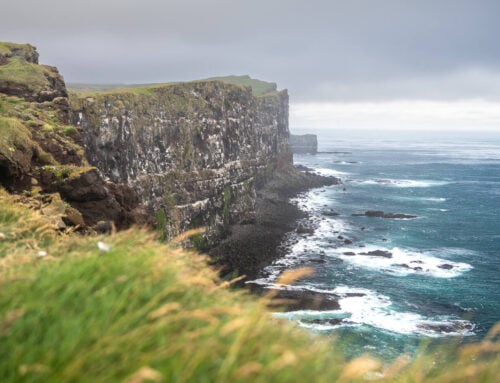
Leave A Comment